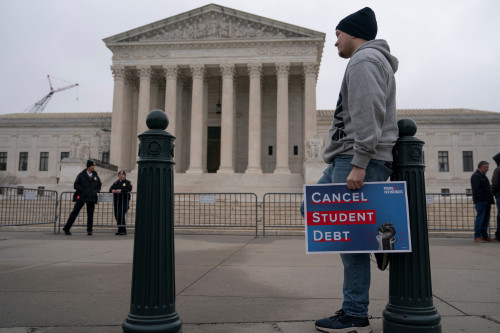(Reuters) -U.S. President Donald Trump’s new tax and spending measures, which he signed into law on Friday, will hit some students in their pocketbooks when it comes to federal financial aid.
The law will affect the amount that students and their families can borrow, as well as eligibility for Pell Grants, designed to help low-income undergraduate students. It will also put colleges and universities on the hook if their students fail to earn more than they would without a degree. Most changes take effect on July 1, 2026.
GRADUATE LENDING AND LOAN CAPS
Grad PLUS loans will be eliminated. They were created in 2006 to help graduate students cover the cost of attendance that exceeded the maximum $20,500 a year that graduate students received through unsubsidized Stafford loans. As of this year’s second quarter, there were 1.8 million Grad PLUS borrowers, who had borrowed a total of $117.2 billion to pay for graduate school attendance, according to Federal Student Loan Portfolio data.
Unsubsidized graduate borrowing for master’s programs will be capped at $20,500 per year ($100,000 lifetime); $50,000/year for professional programs such as law and medicine ($200,000 lifetime). Right now, borrowers can apply for a Grad PLUS loan up to the cost of program attendance if they need more to cover tuition or living expenses.
Parent PLUS loans will be subject to some changes. Parents can borrow if their student borrows the maximum limit of an unsubsidized Stafford loan and still has a remaining unmet need based on cost of attendance. Today, there is $114.3 billion owed across 3.6 million borrowers, according to Federal Student Loan Portfolio data.
LOAN REPAYMENT
Borrowers taking out loans after July 1, 2026, will have access to only two repayment plans: a standard repayment plan to be paid over 10-25 years, and a repayment assistance program where payments will be based on 1-10% of a borrower’s income, with a minimum monthly payment of $10. The remaining balance will be forgiven after 30 years.
DEFERMENT AND FORBEARANCE
The law has eliminated both Economic Hardship and Unemployment Deferment programs, which are tools for borrowers with financial challenges. Economic Hardship Deferment pauses payments, but interest still accrues. Once payment continues, accrued interest is added to the principal. As of this year, 70,000 borrowers under economic hardship deferment had $2.7 billion of outstanding debt, according to federal loan data.
Under unemployment forbearance, borrowers can request to pause their payments, and interest accrues during the pause. Once payments restart, the accrued interest is added to existing interest, instead of the principal.
Under the new law, borrowers can claim forbearance for only nine months within a 24-month period. In the current system, they can request it for 12 months at a time, for a total of three years or 36 months.
PELL GRANTS
Pell Grants are the first dollars awarded to low-income students who have yet to earn a post-secondary degree. Eligibility is based on household income, and 31.6% of undergraduate students received a Pell Grant in 2022, with an average award amount of $4,875. For the 2024-2025 school year, 2 million recipients received a total of $10 billion in Pell Grant aid, according to the federal student aid website.
With the changes, Pell Grants will be the last aid provided. If students are offered full or partial scholarships from their schools or receive any outside scholarships, their eligibility for Pell will be limited.
SCHOOL ACCOUNTABILITY
The new law has created an accountability system that requires colleges to maintain positive outcomes for students in order for their programs to be paid using federal student loans. So-called low-earning outcome programs, or programs where the median earnings of graduates are less than a comparable working adult, are not eligible for federal funding.
The law also makes changes to the gainful employment rule, an Obama-era regulation created to ensure that career training programs, mainly at for-profit institutions and non-degree programs at any institution, prepare students for jobs with adequate earnings to repay their student loans and to justify the investment in the program. It introduces a new standard based on graduate earnings that could have a similar effect on college program eligibility for federal funding.
(Reporting by Nicole Jeanine Johnson in WashingtonEditing by Heather Timmons and Matthew Lewis)



